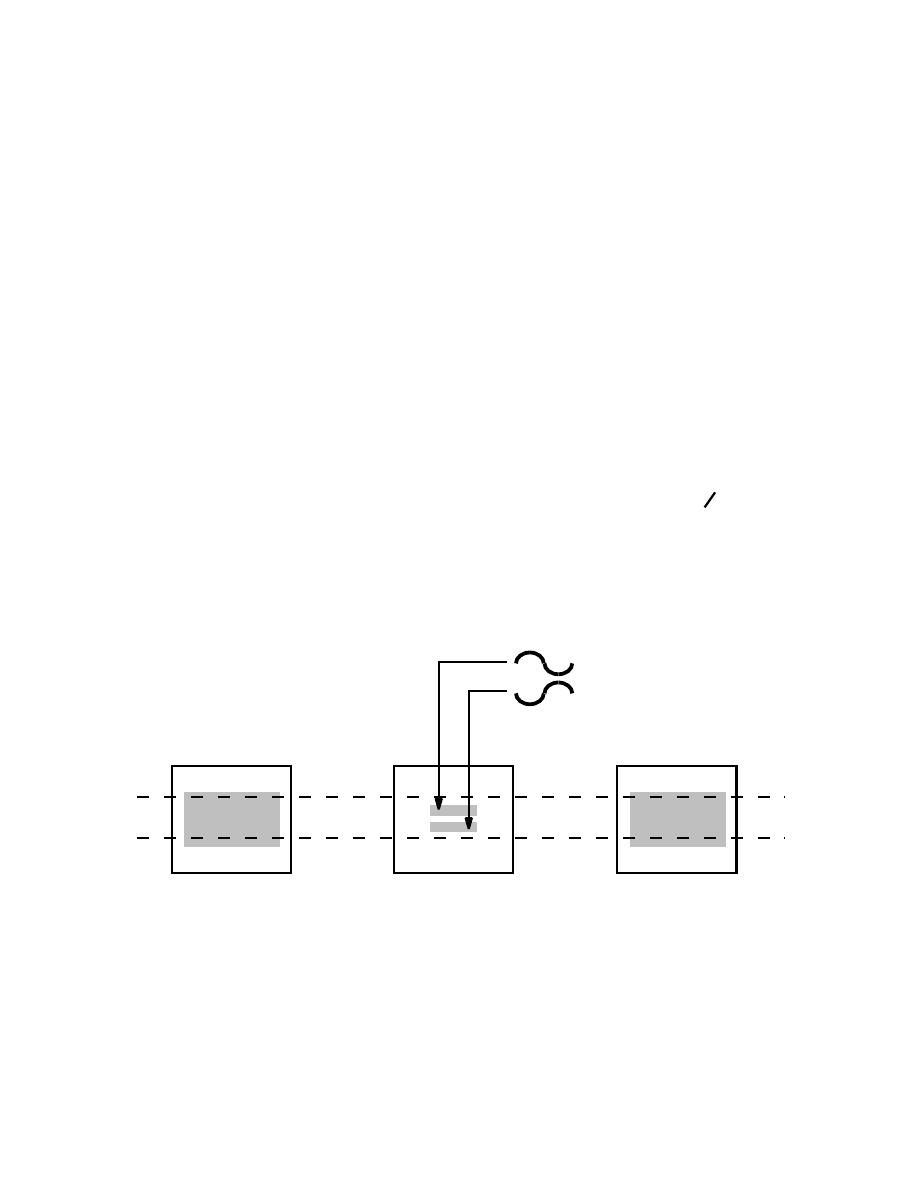ВУЗ: Казахская Национальная Академия Искусств им. Т. Жургенова
Категория: Учебное пособие
Дисциплина: Не указана
Добавлен: 03.02.2019
Просмотров: 12359
Скачиваний: 6

M
multimode filter: A type of filter which has a switch that allows a choice among lowpass,
highpass, and bandpass modes.
multipath distortion: Multipath distortion is a type of distortion afflicting FM and television
broadcasting. It is the receipt of the transmitted signal over more than one path due to reflec-
tions of the audio/video waves off of hills, buildings, etc. Because the path lengths are differ-
ent, there is a delay between the various signal arrival times. In TV, this causes the familiar
“ghosts,” or multiple images, on the screen. In radio, this is the “caught between stations”
effect.
Multiple Loop Points: A category of message in the SDS which allows loop points to be de-
termined or changed within a sampler independently of the sample itself, i.e., without having
to retransmit the entire sample. Loop Points Request and Loop Points Transmit are two such
messages.
multiple loops: The ability of a sampler to handle more than one loop in any given sample.
Some machines allow only two loops per sample, while others allow as many as eight.
multiple mixer: A mixer which provides more than one combined output signal.
multiplex: When signals are combined in such a way that they can later be separated, they
are said to be multiplexed together. A multiplexing device is called a multiplexer, abbreviated
mux. One use of a mux is, in digital recording, a device that converts parallel data to serial
format for output onto a MIDI network. Or, in an A/D, each sample is a binary number of
bits equal to the bit depth of the word, e.g., a 16-bit sample for CD. All 16 bits cannot be
stored to tape simultaneously, so a mux is used to sequence the bits for recording. A demul-
tiplexer reassembles the sequenced data into complete word-samples again.
multisample: The distribution of several related samples at different pitches across the key-
board. Multisampling can provide greater realism in sample wavetable synthesis, since the in-
dividual samples don’t have to be pitch-shifted over a large frequency range, with the result
that the full range of pitches, timbres, and dynamics of the instrument are more accurately rep-
resented. The point on the keyboard at which one sample meets another is called the multi-
sample split point.
multisession: Allows the track-at-once recording of independent sessions to be written to
blank sections of a CD. In multisession mode, the disc is finalized after the last session.
Compare with disk-at-once, whereby the entire disc is written as one session.
multistage: See envelope generator.
multitap: In digital delays, the ability to obtain delayed output signals, usually via patch
points, at more than one point as the signal passes through a series of delay circuits. The sig-
nals derived at each of these taps, each with a different delay time, can be routed to separate
destinations.
multitimbral: Capable of making more than one tone family (also called a tone color or tone
timbre) at the same time, i.e., a device which can respond on multiple MIDI channels at once.
A typical multitimbral tone generator can play, for example, the brass, piano, and violin parts
all at once. GM requires 16-part multitimbral synthesis capability. Each multitimbral part
can play polyphonically, that is play chords, up to the polyphonic voice limit of the module.

M
multitrack: An audio tape recorder capable of handling more than two tracks of information
separately, but generally applied to recorders which handle eight or more tracks. Otherwise,
the recorder is called a two-track or four-track recorder. Also, the actual recording tape on
which eight or more tracks are recorded. The tape is nonsprocketed and the recorder may be
analog or digital. The most common analog format is 24-track, 2” tape; the digital market is
shared between the DASH format, using either 24- or 48-track
1
2
” tape or the ProDigital
format which records 32 tracks on 1” tape. MEMs use video cassettes to record 8-12 tracks of
audio, but up to 128 tracks can be simultaneously recorded by locking together multiple
transports.
multitracking: (1) The use of wide-format audio recording tapes on which parallel tracks are
recorded, each containing a performance by one or more instrumentalists, vocalists, or virtual
tracks. (2) See overdubbing.
multi-WAV: See WAV/multi-WAV drivers.
munchkin effect: The effect produced by pitch-shifting a sample sufficiently to produce dis-
tortion in the shifted tones.
MUSICAM: Masking pattern adapted Universal Subband Integrated Coding And Multi-
plexing. The first name given to what is now known as ISO/MPEG Layer II audio encoding.
music cue sheet: A list of music used in a film soundtrack, along with its type of usage
(source, BG instrumental, visual vocal, etc.), i.e., not a conventional cue sheet.
music house: A company with staff composers, arrangers, and producers, and which has its
own studio, engineering staff, etc. Clients in need of custom music can contract with the mu-
sic house for a finished piece, instead of having to hire and manage all of the various creative
and technical personnel and required equipment and facilities.
music track: (1) An edited track of magnetic film containing music. There may be more than
one music track for a film, especially if the editor calls for a dissolve between two scenes,
each with its own music track. (2) In a 35mm three-track mix, the “M” in DME.
mut: Make-Up Table. The motor-driven bench designed to load an rewind film. Mut usually
refers to the setup that drives a large reel of mag film during a double-system preview screen-
ing.
mute: (1) A control on a mixer which allows the channel to be removed from the mix without
touching the channel fader, which may be preset to the precise level called for by the compo-
sition. (2) A device placed on or in a musical instrument with the intention of reducing its
volume or altering its timbre. (3) (verb) To cut off a sound, input, or track suddenly.
mute mode: In mixing console automation systems, an operational write mode in which the
engineer enters off/on commands for various channels, turning these off and on to avoid
noise, mistakes, and any unwanted sounds.
mute-write: The operating mode of mixer automation systems in which the engineer’s real-
time mute commands are written to tape or disk to be saved for subsequent passes and re-
use.

M
mutual angle: The angle between microphones in a coincident pair. It is possible to change
the mutual angle over a small range to adjust the precise relationship between the physical
sound source positions in front of the microphones and their perceived positions in the stereo
image.
mux: See multiplexing.
mylar: A strong polyester plastic used as a base for most recording tape. Mylar is stable,
easily coated, and retains its elasticity in extended storage. The word is a Dupont Co. trade-
mark, but the term is used generically for any polyester-base recording tape.

N
NAB: National Association of Broadcasters. A body involved in the specification and devel-
opment of technical standards in the U.S. audio and broadcasting industry.
NAB characteristic: The pre-emphasis and de-emphasis equalization standard for magnetic
tape recording adopted in the U.S. and Japan.
NAB spool: The 10” metal tape spools used on professional tape recorders.
Nagra: A Swiss brand of professional recorder originally designed to record on-location syn-
chronous sound for motion pictures, the industry standard for thirty years, owing to the
quality and ruggedness of the recorders. It uses
1
4
” tape and is generally equipped with a
crystal sync generator. Originally Nagras were portable, designed for used while being car-
ried, and are equal in quality to high-end studio recorders. There are now various models
and track formats, including some made just for studio use for making transfers, film mixes,
etc. Nagra makes both digital and analog recorders, mono and stereo; use of a stereo Nagra
on-location is almost always to record two separate mono tracks simultaneously, and does
not usually mean a stereophonic recording. Nagra means “recorded” in Polish, founder
Stefan Kudelski’s native language, and the recorders are manufactured by Kudelski S.A. See
neo-pilot.
Nagra-D: The digital version of the Nagra recorder, using
1
4
” tape to record up to four tracks
of 20-bit audio.
Nagramaster: An equalization curve developed for use by Nagra recorders that uses an HF
boost during recording and de-emphasis during playback to increase the SNR at 15ips.
NAMM: National Association of Music Merchants. A trade association of musical instru-
ment retailers.
nano: Prefix meaning, “one billionth of the quantity that follows.”
nanoweber: A unit of magnetic flux, one-billionth of a weber. On recording tape, specific or
reference flux density is measured in nanowebers per meter.
narrowband: A relatively short frequency span, defining a signal or filter which encom-
passes a small spectrum bandwidth, as opposed to wideband or broadband. Filters sharper
than one-third octave are generally considered narrowband filters.
natural: A symbol ( ) which is used to cancel the effect of a sharp or a flat.
natural frequency: See resonance.
NC Curve, NC Contour: Noise Criterion. The ambient or background noise in an auditorium
or room. See walla, ambience, room tone.
N-Curve: Same as Academy curve. See X-Curve.

N
near-coincident pair: A spaced-pair microphone technique which uses directional micro-
phones, placed approximately 7” apart, or the average spacing between ears on a human
head. This allows for some amount of phase difference in the two signals, but not enough to
lose mono compatibility, combining the level difference recording characteristics of direc-
tional coincident-pair microphones in a spaced array. ORTF is the most common near-
coincident arrangement, but others include NOS, and the Faulkner array.
near-field: The sound field very close to a sound source is called the near-field. By “very
close” is meant less than one wavelength at the frequency of interest. A near-field speaker is a
compact studio monitor designed for listening at close distances (3’-5’) so, in theory, the ef-
fects of poor room acoustics are greatly reduced. See also far-field, reverberant field.
needle-drop: Any single section of music, no matter how short, copied from a music library
for use in a film or video soundtrack, or a commercial spot. The producer or client must pay
the specified fee to the library or copyright owner for each needle-drop, even when the same
section is used more than once in the production.
negative feedback: See feedback.
neo-pilot: A system for the synchronization of a motion picture camera with a
1
4
” tape re-
corder recording the sound, using a superimposed crystal sync pilot tone generated by the
camera or an oscillator, usually at 50Hz or 60Hz, on the full-track tape in such a way that it is
not sensed by the normal full-track playback head, and so is not heard with the recorded
sounds. The recovered signal is used to control the speed of the tape recorded in playback so
the sound remains in sync with the picture. This process is called resolving. Developed for
use in analog, mono Nagra recorders.
Neo-Pilot Tone
-
PHASE
+
PHASE
Record
Head
Pilot
Head
Playback
Head
The sync head records two thin tracks of sync tone near the center of the tape. These thin
tracks are read by the resolving circuits that control the motor speed of the player to maintain
correct synchronization. As the sync signals are in antiphase, when both tracks pass the play-
back head simultaneously, they are phase-cancelled.